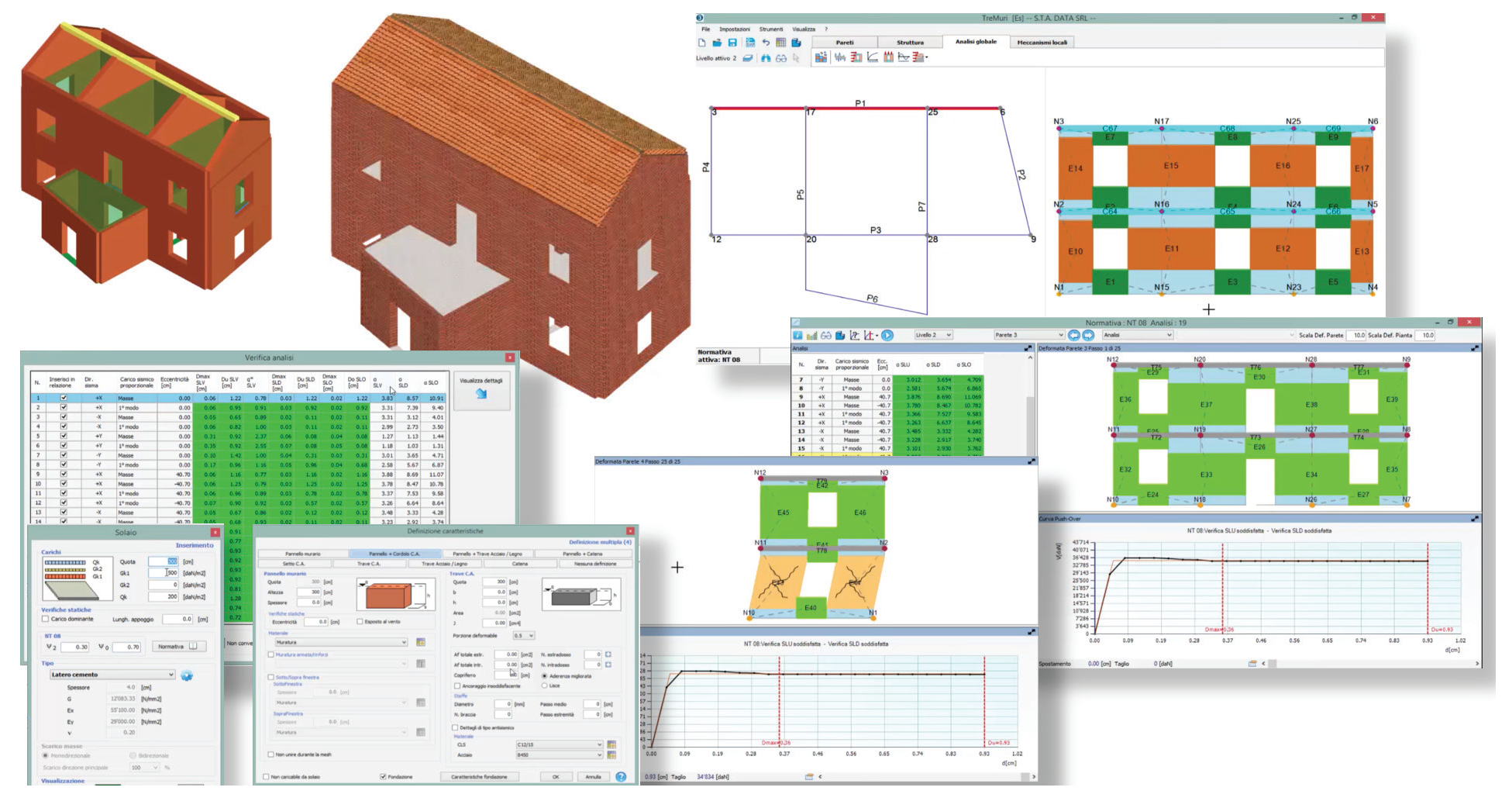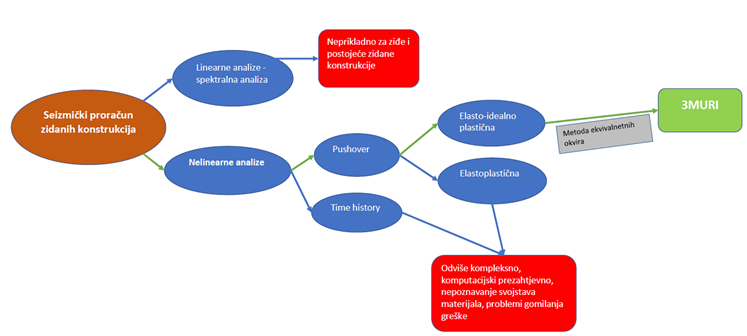3Muri is a program for numerical assessment of seismic resistance of masonry structures.
Masonry as a building material is considered to be the oldest material that has a wider use in today’s construction. Nevertheless, the use of masonry as a structural material has been significantly reduced, mainly due to the wider use of concrete and steel, while regulations for the design of masonry lag significantly behing the regulations for other materials. When it comes to estimates of already existing masonry structures, the situation is even more complicated – ignorance of basic calculation parameters, such as material properties and stiffness parameters exclude classical finite element calculations as correct procedures. The question is whether the load-bearing capacity of existing masonry structures can be numerically evaluated, and if so, with what reliability.
What is the 3Muri program?
3Muri is a software for the analysis of masonry strucutres and mixed system structures (masonry – concrete) via a nonlinear static pushover method. 3Muri is suitable for old and new buildings. 3Muri provides the possibility of performing static analysis (EC6) and pushover analysis of masonry structures (EC8). 3Muri is also known for its abillity to model the reinforcement of masonry structures with steel, FRP and FRCM systems. 3Muri also offers the possibility of local calculations through local verification of the stability of walls outside the plane.

Numerical estimation of seismic resistance of masonry structures
As masonry is a material that shows extremely hysteresical properties in seismic action, high nonlinearity and stiffness degradation. nonlinear methods should be used in the evaluation of seismic resistance, and some national standards for the design of structures already require it. We distinguish two basic nonlinear methods – calculation by analysis of seismic time history and the method of gradual pushover,
Time history masonry analysis are now used only in science and due to their overall complexity, numerical complexity and difficulty in interpreting the results are not applicable in the profession. Therefore, the use of pushover analysis remains. Pushover analysis in most commercial FEM software is possible for steel, but for materials that show lateral load stiffness degradation (masonry), most programs do not have sufficiently robust alghoritms that could achieve static balance after the material enters the ”descending” branch of the diagram what results in a ”singular matrix” error after exceeding a certain load level. In addition, even in the absence of such numerical limitations, knowing the entire elastoplastic curve of the masonry (and especially the existing, old masonry) is a very unlikely scenario. Therefore, further simplifications are needed. Consequently, simplified methods for the calculation of masonry structures have recently been developed. The method of equivalent frames, which was adopted in the 3Muri program, proved to be the most accurate, and today the most frequently used (Lagomarsino et al, 2013).

Due to its simplicity, computational unpretentousness and accuracy, the method is currently the most suitable tool for seismic evaluation of existing masonry buildings. This method has its roots in visual inspections of buildings damaged in earthquakes, where the crack pattern clearly identifies the basic load-bearing elements of masonry structures – vertical load-bearing elements (piers) and span elements (spandrels).

After the identification of the mentioned elements, an equivalent frame is formed from vertical and horizontal elements of adequate rigidity, and the analysis that is performed is mathematically viewed – elasto-ideally plastic analysis. Clearly, the abouve simplification has certain consequences – for example, neglecting the membrane behaviour of walls and neglecting the stiffness of walls outside the plane. The justification of these simplifications is clear, for example, the stiffness of the masonry outside the plane in negligible in the global behaviour of the structure. Behaviour outside the plane is then observed completely separately in the calculation of the masonry, in the analysis of the stability of the walls outside the plane (”out of plane analysis’ in the 3Muri software). For example, such local stability analysis make it very easy to identify the mechanism of overturning the gable wall, which in classic FEM software would be missed by most engineers since the software would rigidly connect the gable with eg the rafter element. The advantages of this method are numerous: significantly reduced number of degrees of freedom of the system resulting in fast calculation, simplicity in modeling, no accumulation of numerical error, simplified analysis and interpretation of results…
Analysis of the existing masonry – seismic calculation without extensive field tests
As already explained, the analysis of existing masonry structures requires special methods and a specific theoretical basis. The basics are contained in the standard EN 1998-3 which refers to the seismic assessment of existing buildings, but still this standard provides very concise instructions and guidelines and lags significantly behind the Italian regulations that are at the forefront in this area. In fact, for an efficient seismic evaluation of existing masonry structures, we still have to rely on the guidelines of Italian regulations (which are not in conflict with EN but complement it). In addition, the regulations instruct us to use adequate software to perform the analysis.
Currently, the choice of software is not a big dilemma since 3Muri is the only suitable tool for assessing existing masonry buildings. What is very useful with 3Muri software is the fact that the software offers the use of various options based on the Italian standard, which, as already explained, is significantly more advanced than the European standard. For example, one of the more useful tools in 3Muri software is the assessment of the mechanical properties of materials from masonry type information.
This is something that the European standard does not offer, and it is clear that most investors do not want to conduct extensive laboratory tests of embedded materials. In this case, the designer declares ”level of knowledge 2” on the construction [EN 1998-3; 3.3.3], and the possible variability of material properties is covered by the factor from the European standard. In this way, it is possible to perform a seismic resistance calculation without costly material testing, and reliability is ensured by adequate factors and coefficients. In addition, 3Muri software offers a variety of options tailored for existing buildings, such as seismic reinforcement calculations (e.g. FRP, steel cables, frames…).
Although there are other software adapted to the analysis of masonry structures such as 3Muri, which also uses the method of equivalent frames (e.g. AMQuake), they are not adapted to the analysis of existing structures, but only new ones. For example, it is possible to choose only a rigid ceiling, do not contain the possibility of remediation and reinforcement, do not offer the ability to assess the characteristics of masonry, do not offer different mechanisms of failure of the masonry, etc.
Conclusion
From all the above, it is clear that the seismic calculation of existing masonry structures is a very demanding task. It can be said that this task is a real engineering task, much more demanding than classical static calculations, because it requires thinking about construction, materials and joints. The 3Muri program has proven to be useful fort his type of tasks.
By combining the calculation of global resilience and local stability, a correct assessment of existing building is possible. As a tool, there are adequate software programs such as 3Muri that allow the implementation of the analysis, and are organized in such a way that sufficient reliability prescribed by the European standard is ultimately achieved.
It is clear that the calculations reliability of existing buildings cannot be at the level of the calculations of new buildings, but with tools like 3Muri, it is possible to perform calculations that are satisfactory – and ultimately make a difference in deciding whether the object has to be removed, strenghtened or the reliability is at a satisfactory level.
Written by: Domagoj Grabovac, mag.ing.aedif.
Learn the 3Muri program!
Download the free demo version of 3Muri. You can also visit the official site for more information, here.
.
Watch the free tutorials for beginners in the 3Muri program.
